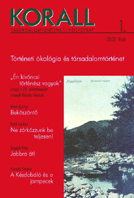Árpád-kori csatornarendszerek kutatása a Rábaközben és a Kárpát-medence egyéb területein I. rész
The research of water gang systems of the Arpadian age in Rábaköz and in other parts of the Carpathian basin. I. part
Author(s): Károly TakácsSubject(s): History
Published by: KORALL Társadalomtörténeti Egyesület
Keywords: social history; environment and society; 11th–13th centuries; Hungary; river training; canal
Summary/Abstract: In the course of the archeological and historical researches we conducted in several distant areas of Hungary, we found destroyed canalization systems. According to the information at our disposal, these canals are probably the — until the present unknown — remnants of the Árpád-period water-system. Serious arguments underline the hypothesis that the observed canalization systems were covering all areas touched by water (plains, river valley areas) in the Carpathian Basin. Charactcristically, in all areas already examined, the canals of the Árpád-period were found to be complex systems. Due to their specific construction, it was more or less simple to reconstruct their operation. Canalization systems were twofold constructions: they served the irrigation and the nourishing of fish ponds, while alsó carrying off and draining away the water. Because of their complex functions, medieval canals used to build extraordinarily dense networks. At somé areas, that have been more thoroughly researched, ten-twenty times as many canals were discovered underearth as operating on the same spots presently. In written sources, the canals of the Árpád-period appear under diverse (Latin and Hungarian) terms. Among these, the word "árok" (ditch) and its Latin equivalent "fossa" (other forms: fossatum, fossata, fossatura, fossura) bear eminent positions — it seems that these were-the primary terms indicating canals. We frequently encounter them in certificates from the Árpád-period, among these primarily in bordér descriptions. Based on somé letters of privilege, we might rightly assume that the digging of canals was one of the communal services in llth-12th-century Hungary, that members of subordinate layers of society were generally subjected to. The construction and sustainment of canals was provided by the well-known hierarchical institutions of the Árpád-period: the fortressand court system. Consequent to the foregoing research results, the econornic and social system of early medieval Hungary need to be rethought.
Journal: Korall - Társadalomtörténeti folyóirat
- Issue Year: 2000
- Issue No: 1
- Page Range: 27-61
- Page Count: 35
- Language: Hungarian

